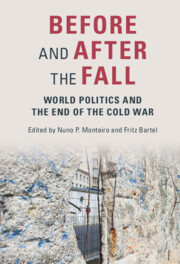Book contents
- Before and After the Fall
- Before and After the Fall
- Copyright page
- Dedication
- Epigraph
- Contents
- Figures
- Tables
- Contributors
- Preface
- Introduction
- Part I Sources of Continuity and Change
- Part II Continuity and Change Across the 1989/1991 Divide
- Part III Toward a New World Order?
- 12 Great Powers and the Spread of Autocracy Since the Cold War
- 13 Seeds of Failure
- 14 The United States and NATO After the End of the Cold War
- 15 The Historical Legacy of 1989
- 16 Requiem for a Cold War
- 17 After Primacy
- 18 World Order across the End of the Cold War
- Index
17 - After Primacy
Exploring the Contours of Twenty-First-Century Great Power Rivalry
from Part III - Toward a New World Order?
Published online by Cambridge University Press: 02 December 2021
- Before and After the Fall
- Before and After the Fall
- Copyright page
- Dedication
- Epigraph
- Contents
- Figures
- Tables
- Contributors
- Preface
- Introduction
- Part I Sources of Continuity and Change
- Part II Continuity and Change Across the 1989/1991 Divide
- Part III Toward a New World Order?
- 12 Great Powers and the Spread of Autocracy Since the Cold War
- 13 Seeds of Failure
- 14 The United States and NATO After the End of the Cold War
- 15 The Historical Legacy of 1989
- 16 Requiem for a Cold War
- 17 After Primacy
- 18 World Order across the End of the Cold War
- Index
Summary
What will be the contours of the “post-post-Cold War” world? This chapter takes up that question by examining the defining international and domestic characteristics of this new age and assessing their similarities with previous eras. We begin by identifying three defining attributes of the Cold War: ideological clash, limited economic exchange, and nuclear arms racing between the American and Soviet-led blocs. Next, we explore the central feature of the post-Cold War era - namely, American primacy. We then examine the trends that have eroded primacy's material underpinnings and produced new domestic and International conditions — global power shifts, technological change, and sociopolitical fragmentation -- then project forward how those trends are likely to evolve over the next ten to fifteen years. Finally, we examine the extent to which those trends are distinct from, or continuous with, the conditions facing the United States during the Cold War and post-Cold War eras, and find that some important continuities remain even as meaningful discontinuities will disrupt existing patterns of international order. The chapter concludes by arguing that the post-post-Cold War world requires a new strategic approach for the United States — one guided by a principle of openness, rather than Cold War-style containment or post-Cold War-style liberal universalism.
Keywords
- Type
- Chapter
- Information
- Before and After the FallWorld Politics and the End of the Cold War, pp. 319 - 337Publisher: Cambridge University PressPrint publication year: 2021

